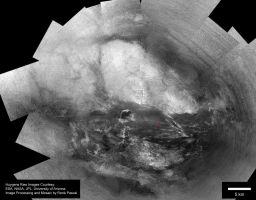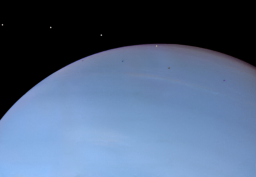Emily Lakdawalla • Oct 05, 2010
I'm So Proud 2: Announcing AmateurSpaceImages.com
The first announcement I made today was the new partnership between the Planetary Society and UnmannedSpaceflight.com. The second is the launch of a new project that is near and dear to my heart: AmateurSpaceImages.com. It doesn't exist yet; we've registered the URL, but there's nothing there but a 1996-era index page with a couple of pictures. But I hope that in a few months, it will be much more: the online source for amateur-processed images from space missions. In order to do it, I need your help. And when I say "help," I mean "money."

ESA / NASA / JPL / University of Arizona / René Pascal
Large surface mosaic of Titan
This mosaic was stitched by amateur image processor René Pascal from the Huygens DISR data. The mosaic is mostly composed of Medium Resolution Imager data, supplemented with some High Resolution Imager and some Side Looking Imager data.
NASA / JPL / Ted Stryk, Roane State CC
Despina eclipses and transits Neptune (Despina brightened)
Despina, 148 kilometers across, is a tiny moon of Neptune located within its ring system and discovered by Voyager 2 in 1989 as the spacecraft approached for its flyby. This view of Despina eclipsing and transiting Neptune is composed of four frames captured nine minutes apart on August 24, 1989 from 20:00 to 20:27 through blue, orange, violet, and green filters. The images were originally captured to study the colors of Neptune's clouds; the fact that Despina and its shadow were visible in the images was discovered by amateur image processor Ted Stryk in 2009.At AmateurSpaceImages.com we will post photos from both ongoing and ancient missions, from across the solar system. You'll be able to share the images via social networking sites, download them for use in your presentations and Web articles, and discuss them with each other. Just like UnmannedSpaceflight.com it'll be moderated to maintain a high standard, so that when you search on "Rhea" or "Lutetia" or "Mercury" you'll get images that can serve as illustrations, either print or online. And we will make sure that the credit for each image is clear -- both for the missions and science teams that originated the data, and for the amateurs who took that data and produced something amazing from it.
If you care about the stunning images returned from space missions, if you want to see more like them, if you have ever had a hard time finding that amazing amateur-processed mosaic of Huygens' landing site or that newly discovered view of Neptune's tiny moon Despina, please donate to support me in developing AmateurSpaceImages.com. Donate here!
Let’s Go Beyond The Horizon
Every success in space exploration is the result of the community of space enthusiasts, like you, who believe it is important. You can help usher in the next great era of space exploration with your gift today.
Donate Today

 Explore Worlds
Explore Worlds Find Life
Find Life Defend Earth
Defend Earth

